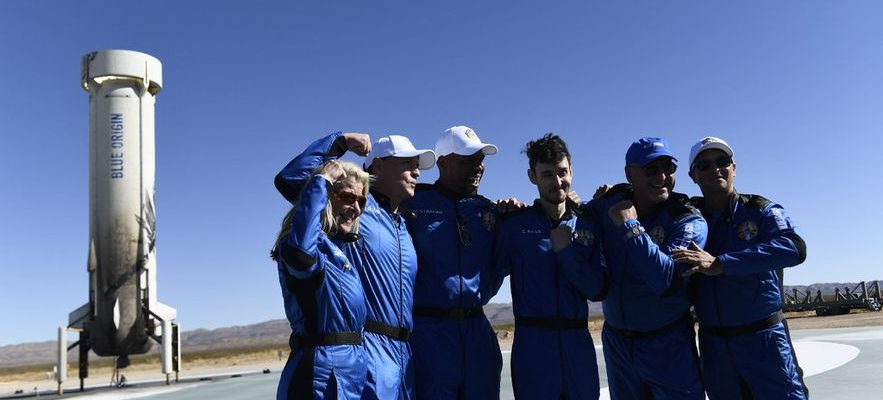Extreme tourism has a cost. And not only financially: since Sunday June 18, five passengers have disappeared on board a tourist submarine from the company “OceanGate Expedition” which took them on an expedition to observe the world-famous wreck of the Titanic, at 3800 meters deep. off Canada. Among them, the 58-year-old British billionaire Hamish Harding, who went into space with Jeff Bezos a year ago, and already holds the world record for diving in a pocket submarine, at nearly 11,000 meters deep. These extreme tourist attractions are popular with billionaires, who pay ever more staggering sums to have access to the ultimate dose of adrenaline.
- The fascination for journeys into the depths
In the case of the “OceanGate Expedition”, the passengers of the submersible named “Titan” had paid 250,000 dollars to see with their eyes the mythical wreck which has been resting since 1912 at 4000 meters deep, 650 kilometers from the Canadian coast. All aboard a submersible 6.70 meters long, with an oxygen autonomy of 96 hours.
There are about thirty tourist submarines in service around the world. Often located in islands such as the Canaries or Hawaii, the vast majority of them nevertheless descend only a few tens of meters to observe the local fauna, for a period of one to two hours and a hundred euros.
But some want to go further. In May 2019, the wealthy American and seabed explorer Victor Vescovo became the fourth human to reach the deepest point of the ocean aboard a submarine, as part of an expedition in the pit of the sea. Mariannes, 11,000 meters deep. He had himself built the “DSV Limiting Factor”, and had provided it with scientific equipment to make it available to researchers, at a total cost of 48 million dollars. Before him, the director of the film titanic James Cameron had notably undertaken the same expedition.
The submarine builders quickly spotted the vein. For ten years, the Triton company has offered to provide the ultra-rich with “leisure” submarines for personal use, capable of descending up to 1,000 meters under water. James Cameron and the American billionaire Ray Dalio are the owners, and have even become investors in the brand. Their commercial models can accommodate up to 66 people and descend to a maximum of 500 meters.
- The booming space tourism industry
One of the crews of the Blue Origin NS-19 rocket after their journey of a few minutes in space, in 2021 in Texas.
© / afp.com/Patrick T. FALLON
The fascination of men, and in particular billionaires for space travel is not new. In 2001, Californian businessman Dennis Tito was the first space tourist, paying $20 million to the Russian Federal Space Agency to take part in the Soyuz-TM-32 mission.
What was a one-off, off-the-beaten-track expedition has since morphed into a luxury tourism industry. Between June 27 and 30, the company of billionaire Richard Branson, Virgin Galactic will thus launch its first commercial flight in space, which should be repeated every month, at a cost of 450,000 dollars per passenger. The company thus joins the company of the richest man in the world, Jeff Bezos, Blue Origin, which has already sent passengers above the 100 kilometer altitude barrier considered to be the limit on several occasions. between Earth and space, for an average duration of 90 minutes aboard its rocket New Shepard. Since 2021, Elon Musk and his company SpaceX have gone even further by offering a three-day orbit around the earth, for around $50 million per person.
- The great return of luxury zeppelins

Euro Airship’s future airship
© / EuroAirship
It is the return of a means of air transport once dedicated to the more affluent: airships, aircraft carried by a balloon and propelled by propellers, which had known their hour of glory as the first long-haul aircraft capable of connecting Europe to America from 1919. Travel by zeppelin had been abandoned after the trauma of the crash of the LZ 129 Hindernburg, destroyed by fire during a landing in 1937, killing 35 people.
For several years, the British company Hybrid Air Vehicles has been promising the return to the air of a 40 million euro airship with a zero carbon footprint, the Airlander 10. 100 meters long (more than an Airbus A80 ), according to the company, it will be capable of transporting 16 passengers noiselessly over several thousand kilometres, all in luxurious cabins and for a ticket with an estimated value of 20,000 to 30,000 euros. The company promises commissioning by 2024. Other manufacturers or ecological tourism companies have since joined the dream. The aircraft manufacturer Lockheed Martin is working on several hybrid balloon projects. A French start-up, Flying Whales, raised 30 million euros at the end of 2019 for a similar project, while another French start-up, Euro Airship, plans to develop a 150-meter long airship, combining solar sails , fuel cell and hydrogen to propel itself.
